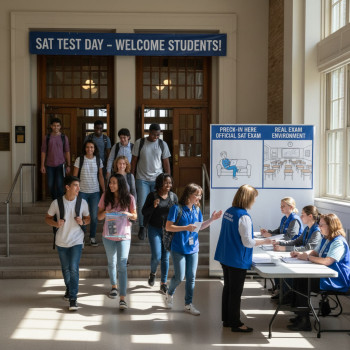Introduction: Why This Matters to Parents
Watching your child walk out of an SAT test center — a mix of exhaustion, relief, and maybe uncertainty — is a familiar scene for many families. As a parent, you want to help: to calm nerves, to make smart decisions, and to make sure your student’s time and effort are invested wisely. One of the first questions that often comes up is: should we retake the SAT? And if so, when and how?

This article breaks down SAT retakes from a parent’s perspective. We’ll cover the practical rules you need to know, how colleges commonly treat multiple scores, realistic timelines, study strategies that actually move the needle, and the emotional support students need to do their best. We’ll also talk about personalized tutoring options—like Sparkl’s 1-on-1 guidance and tailored study plans—to help make retakes strategic instead of stressful.
Quick Facts Every Parent Should Know
Before we dive into guidance and scenarios, here are the baseline facts — straightforward and practical. Keep these in your back pocket as you decide whether a retake makes sense.
- The SAT can be taken as many times as a student wants; there’s no cap on retakes.
- Most students take the SAT at least twice: once in the spring of junior year and again in the fall of senior year.
- Many colleges superscore: they combine the best section scores from different test dates to create a higher composite score.
- Colleges set their own score-use policies — some look at the highest composite score, some superscore, and some may ask for all scores. Check each college’s policy when possible.
- Scores for the digital SAT are generally available within a few weeks of the test date; plan around college application deadlines so scores arrive on time.
How Colleges Typically Treat Retakes
Understanding how colleges view multiple SAT results helps you decide if a retake is worth it.
Superscoring: What parents should know
When a college superscores, it takes the student’s top Math section and top Evidence-Based Reading and Writing (EBRW) section, even if those results come from different test dates, and combines them into a new, higher total. For many students, this makes retaking appealing — you can target your weaker section and potentially boost your overall reported score without needing a perfect performance on both sections the same day.
Some colleges ask for all scores
A smaller set of schools require applicants to submit all SAT scores. If a school has this policy, retaking can still be helpful — but it’s important to be strategic and talk with your student’s counselor about timing and expectations so scores tell the story you want to present.
Holistic review matters
Remember: test scores are just one piece of the puzzle. Admissions teams also weigh GPA, course rigor, essays, recommendations, activities, and context. For many applicants, a reasonable score plus strong academics and a compelling application yields the best outcome.
When Should Your Student Consider a Retake?
Deciding to retake the SAT is both a numbers question and a personal one. Here are practical situations where a retake usually makes sense.
1) The score is below your target
If your child’s score is below the typical range for the colleges they’re aiming for, a retake — with focused preparation — is often worthwhile. Use college score ranges to set a realistic target and plan backward: how many points would make a meaningful difference for admissions or merit scholarship eligibility?
2) The test day had disruptions
Was it illness, an unfamiliar testing device hiccup, severe anxiety, or another one-off problem? If the test experience was not representative of your student’s abilities, a retake can be justified.
3) There’s room for improvement within the study timeline
Students who can realistically invest several weeks of targeted study often see meaningful gains. The key word is “targeted” — blanket studying rarely changes much. Focused work on weak question types, timing strategies, and full-length digital practice is what moves scores.
4) Scholarship thresholds
Many merit scholarships have score cutoffs. If improving by a modest number of points could unlock significant financial aid, a retake is an investment worth considering.
When a Retake Might Not Be the Best Option
- If the score is already within the competitive range for your student’s top choices, further retakes may bring diminishing returns.
- If a retake will cause burnout during critical application deadlines (essay revisions, teacher recommendation coordination), it may not be worth it.
- If the student is overwhelmed or unmotivated — test gains require focused effort, and forced studying can be counterproductive.
How to Make a Retake Plan That Works
A plan that balances realistic goals and sustained momentum is essential. Here’s a simple framework parents can use to help their student design a retake strategy.
Step 1: Diagnose — use the score report wisely
Start with the official score report. Identify which section and which question types caused trouble. Did the student lose points to timing, careless errors, specific math topics, or dense reading passages? Once you know the problem areas, you can prescribe the right medicine.
Step 2: Set a clear target
Pick a target score tied to outcomes: an admissions range, a scholarship threshold, or a personal improvement goal (for example, +40 points total). A clear number helps the study plan stay measurable.
Step 3: Create a focused study schedule
Quality beats quantity. A realistic weekly schedule — for example, 6–10 focused hours per week for 6–8 weeks — is often enough to generate real gains. Mix skills practice with full-length digital practice tests to build stamina and familiarity with the test platform.
Step 4: Use targeted resources
Practice on the official digital platform whenever possible, and prioritize question sets that mirror the student’s weakest areas. If a student struggles with time management, include timed sections in practice. If vocabulary-in-context or evidence-based questions are the issue, focus on those passage-based skills.
Step 5: Consider personalized tutoring
For many students, a few weeks of focused 1-on-1 tutoring can shortcut months of inefficient study. Personalized tutoring provides tailored study plans, targeted feedback, and accountability. Sparkl’s personalized tutoring, for example, offers expert tutors who create tailored study plans and use AI-driven insights to identify weak spots and track progress. For families who want efficient, results-driven preparation, a tutor can be especially useful when the retake timeline is tight.
Practical Timeline: When to Retake for Fall Applications
Timing matters. Here’s a practical timeline parents can use if their student wants to retake the SAT in time for fall application deadlines.
| Action | Recommended Timing | Why |
|---|---|---|
| Take initial SAT (spring of junior year) | March–May (junior year) | Gives time for diagnostic review and targeted preparation before senior year. |
| Analyze results & set target | Within 2 weeks after scores release | Early diagnosis creates time for meaningful improvement. |
| Begin focused prep / tutoring | 6–8 weeks before preferred retake | Allows for targeted practice and at least one full-length digital test under timed conditions. |
| Retake SAT | August–October of senior year (if applying early) | Scores are typically released within weeks and will meet most application deadlines. |
Study Strategies That Actually Help for Retakes
Not all studying is created equal. Here are practical strategies that lead to measurable improvement.
1) Practice on the digital platform
Because the SAT is now administered digitally, practice on the same format is essential. This reduces surprises and builds comfort with navigation, highlighting tools, and the digital calculator.
2) Focus on question types, not just content
Break sections into smaller chunks: algebra and problem-solving in Math; command of evidence and passage structure in EBRW. Targeted drills on weak question types quickly raise accuracy.
3) Simulate test conditions
Run at least two full, timed digital practice tests before the retake. Practice sitting through the session, taking breaks as scheduled, and managing fatigue. This builds both endurance and confidence.
4) Learn from errors the right way
Don’t just mark questions wrong. Ask: why was it wrong? Was it content, misreading, timing, or a careless error? Track patterns — persistent careless mistakes signal a different fix than persistent content gaps.
5) Build a calm routine
Short, consistent study sessions beat marathon cramming. Encourage good sleep hygiene in the weeks before test day — cognitive performance improves much more with sleep and routine than with last-minute all-night sessions.
What Parents Can Do (Without Micromanaging)
Parents play a crucial supportive role without needing to become SAT experts. Here’s how to help effectively.
- Be the organizer: keep track of test dates, registration deadlines, and score release windows so the student isn’t scrambling.
- Provide structure: a study calendar, quiet study space, and healthy snacks go a long way.
- Offer emotional support: validate stress and help your teen put results in perspective.
- Help with logistics: transportation to the test center, managing registrations, and ensuring the testing device is prepped if digital at-home options apply.
- Consider investing in targeted help: a few focused tutoring sessions (for example, Sparkl’s personalized 1-on-1 guidance) can make preparation efficient and tailored to the student’s learning style.
Realistic Expectations: How Much Score Gain Should You Expect?
Families often expect dramatic score jumps after a single retake, but reality varies. Meaningful improvement — 30–80 points on average for many students — is common with targeted preparation; larger gains are possible, especially when initial testing conditions were poor or when prior prep was unfocused. Translating effort into points depends on where your student starts and how strategically they study.
Cost vs. Benefit: When Paying for Tutoring Makes Sense
Tutoring is an investment. For families deciding whether to hire a tutor, consider these factors:
- Time before the retake: tight timelines benefit from an expert who can prioritize content and strategy.
- Student motivation and independence: a student who studies effectively on their own may need only occasional check-ins, while others do better with ongoing accountability.
- Scholarship or admissions thresholds: if a modest score bump unlocks significant financial aid, tutoring often pays for itself.
Personalized tutoring — especially 1-on-1 programs that create tailored study plans — helps target weak areas efficiently. Sparkl’s tutors pair expert instruction with AI-driven insights to highlight the highest-impact topics and track progress, which is especially helpful when you have a single retake window to use wisely.
Emotional and Motivational Support: The Unsung Part of Retaking
Score improvements aren’t only about practice; they’re about helping your child build confidence. Pressure and burnout actually reduce performance. Here are ways to maintain healthy motivation:
- Reframe failure as data: a disappointing score is a diagnostic tool, not a judgement.
- Celebrate small wins: improved accuracy in one question type or a stronger timed section deserves recognition.
- Normalize breaks: short mental rests and balanced schedules sustain long-term progress.
- Encourage autonomy: let students have a say in their study plan so they’re more likely to stick with it.
Sample Parent-Student Conversation Guide
If you’re not sure how to talk about retakes, here’s a short script to keep the conversation constructive and collaborative.
- Parent: “I’m proud of how you handled test day. Can we look at your score report together to see where we might focus if you choose to retake?”
- Student: “I don’t know — I’m upset about one section.”
- Parent: “That’s understandable. We can set a simple, realistic goal together, and if you want, we’ll look into focused help — maybe a few tutoring sessions — so you don’t have to do this alone.”
- Student: “Okay, I could try one more time if we make a plan.”
How to Judge if a Retake Was Worth It
After the retake, compare the results not just by raw score but by the story the scores tell. Did the student improve in targeted areas? Did confidence increase? Did timing or test-taking strategy improve? If scores moved in the direction you intended and other parts of the application remained strong, the retake was likely worth it — regardless of whether the numerical jump was huge.
Final Checklist for Parents Before a Retake
- Confirm target score and why that number matters (admissions, scholarships, or personal aim).
- Check college score-reporting policies and deadlines for the schools on your student’s list.
- Set a focused study schedule (6–8 weeks is a workable minimum for targeted improvement).
- Plan at least two full, timed digital practice tests on the same platform.
- Decide whether to add short-term tutoring to the plan for accountability and expert guidance.
- Arrange logistics: registration, transportation, and test-day supplies.
- Support your student’s wellbeing: sleep, nutrition, and balanced expectations.
Closing Thoughts: Be Strategic, Not Anxious
As a parent, your calm, pragmatic support shapes your child’s experience more than any number of practice tests. Retakes are a tool — powerful when used strategically, but unnecessary when the costs (time, stress, lost focus on other parts of the application) outweigh the potential benefits. Focus on a clear target, a realistic plan, and steady progress.
When expert, personalized help makes sense, 1-on-1 tutoring can turn months of unfocused practice into weeks of high-impact work. Sparkl’s personalized tutoring and tailored study plans are designed to do exactly that: provide expert tutors, focused feedback, and AI-driven insights so each hour of study delivers measurable improvement.
Whatever path you choose, remember this: a single test score does not define your child. With the right plan and the right support, a retake can be a confident step forward — not a source of added stress. You and your student can approach it thoughtfully, strategically, and together.

If You Want Help Planning Next Steps
If this article has you thinking about timelines, targeted practice, or tutoring, start by reviewing your student’s score report together and making a short list of priorities. If you’d like a structured option, consider a short block of personalized tutoring to target the highest-impact weaknesses and build confidence before a retake.
Above all, keep conversations centered on growth: what did you learn from the last test, and what small, realistic changes can make the next test better? That approach — practical, encouraging, and strategic — is the one that helps students thrive through retakes and beyond.















No Comments
Leave a comment Cancel